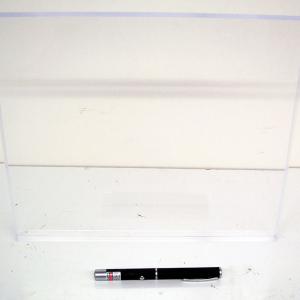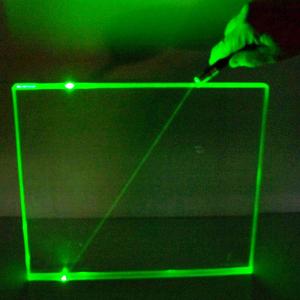College of Liberal Arts & Sciences
6A42.10 - Blackboard Optics - Refraction Block
Video Credit: Jonathan M. Sullivan-Wood
The blackboard optics unit is pretty self explanatory, however there is a pamphlet on its use with the unit and in the file. Do Not run the power supply for the light bulb over 12 volts.
- Wael A. Ramaden, Ahmed Salah El-Tawargy, "An Economic, Compact Apparatus to Verify the Laws of Reflection and Refraction", TPT, Vol. 62, #6, Sept. 2024, p. 520.
- Brianna R. Billingsley, Cory W. Christenson, "Multicultural History of Snell's Law Laboratory Experiment in Introductory Physics", TPT, Vol. 60, #8, Nov. 2022, p. 636.
- Andrew Morrison, "Simple Demonstrations of Refraction Hide Some Deeper Physics", TPT, Vol. 60, #4, April 2022, p. 310.
- Andrzej Sokolowski, "Conceptualization of Light Refraction", TPT, Vol. 51, # 2, Feb. 2013, p. 110.
- Dean Baird, "Figuring Physics", TPT, Vol. 49, # 5, May 2011, p. 262.
- G. Calzà, T. López-Arias, L.M. Gratton, S. Oss, "Playing with Refraction", TPT, Vol. 48, # 4, April 2010, p. 270.
- Thomas B. Greenslade, Jr., "Index of Refraction Using Total Internal Reflection", TPT, Vol. 45, # 7, Oct. 2007, p. 420.
- Alfred F. Leung, "Measuring the Thickness of a Transparent Ring with a Laser", TPT, Vol. 45, # 4, April 2007, p. 239.
- John L. Roeder, "Why Light Won't Refract Through Adjacent Faces of a Cube", TPT, Vol. 45, # 3, March 2007, p. 182.
- John J. Lynch, "Snell's Law with Large Blocks", TPT, Vol. 45, # 3, March 2007, p. 180.
- Mario Branca, Isabella Soletta, "Construction of Optical Elements with Gelatin", TPT, Vol. 41, # 4, Apr. 2003, p. 249.
- Michel Helfgott, "Computer Technologies and the Phenomenon of Refraction", TPT, Vol. 36, # 4, Apr. 1998, p. 236.
- J.M. Dudley and A.M. Kwan, "Snell's Law or Harriot's", TPT, Vol. 35, # 3, p. 158-159, March 1997.
- James E. Kettler, "Index of Refraction by Reflected and Refracted Rays", TPT, Vol. 32, # 3, Mar. 1994, p. 190.
- George Shellenberger, "Using a Standard Force Table to Verify Snell's Law", TPT, Vol. 28, # 6, p. 422, September 1990.
- Stanley Cloud, "A Simpler Derivation of Snell's Law", TPT, Vol. 27, # 4, p. 284, April 1989.
- Roger Blickensderfer, "Used Nomographs", TPT, Vol. 27, # 4, p. 274, April 1989.
- John F. Goehl Jr., "Is the Extrapolation Linear?", TPT, Vol. 26, # 2, p. 105, February 1988.
- P.J. Ouseph, "How Many Fish Are in the Tank?", TPT, Vol. 25, # 7, p. 440, October 1987.
- Roger Blickensderfer, "Systematic Errors and Graphical Extrapolation", TPT, Vol. 23, # 9, Dec. 1985, p. 545 - 547.
- Fred M. Goldberg, "Refraction in Terms of the Deviation of the Light", TPT, Vol. 23, # 1, Jan. 1985, p. 34 - 35.
- A. F. Leung, "Refraction Index Measurement with a Ruler", TPT, Vol. 22, # 2, Feb. 1984, p. 94.
- James H. Nelson, "Relative Index of Refraction Apparatus", TPT, Vol. 21, # 8, Nov. 1983, p. 552.
- J. Neuberger, "Measurement of Index of Refraction", TPT, Vol. 18, # 1, Jan 1980, p. 54.
- F. M. Phelps III and B. S. Jacobson, "Measuring the Index of Refraction", TPT, Vol. 18, # 3, Mar. 1980, p. 216.
- E. D. Hobbs, "Discovering" Snell's Law", TPT, Vol. 16, # 1, Jan. 1978, p. 41.
- Marvin Ohriner, "Experimental Demonstration of Fermat's Principle", TPT, Vol. 3, # 5, May 1965, p. 230.
- Mario Branca and Isabella Soletta, "Construction of Optical Elements with Gelatin", TPT, Vol. 41, #4, April 2003, p. 249.
- D. Drosdoff, A. Widom, "Snell's Law From an Elementary Particle Viewpoint", AJP, Vol. 73, # 10, Oct. 2005, p. 973.
- Jose-Phillippe Perez, "Comment on 'D. Drosdoff, A. Widom, "Snell's Law From an Elementary Particle Viewpoint", AJP, Vol. 73, # 9, Sept. 2005, p. 840.
- D. Drosdoff, A. Widom, "Reply to Jose-Phillippe Perez, "Comment on 'D. Drosdoff, A. Widom, "Snell's Law From an Elementary Particle Viewpoint", AJP, Vol. 73, # 9, Sept. 2005, p. 840.
- J. West, "Comment on 'Fermat's Principle and the Variational Analysis of an Optical Model for Light Propagation Exhibiting a Critical Radius' by M. Marklund, D. Anderson, F. Cattani, M. Lisak, and L. Lundgren, AJP, Vol. 70, # 7, July 2002, p. 680", AJP, Vol. 71, # 7, July 2003, p. 730.
- Harald Helfgott, Michel Helfgott, "A Noncalculus Proof that Fermat's Principle of Least Time Implies the Law of Refraction", AJP, Vol. 70, # 12, Dec. 2002, p. 1224.
- Od-2, 3: Freier and Anderson, A Demonstration Handbook for Physics.
- O-200: "Parallel Displacement", DICK and RAE Physics Demo Notebook.
- Mark Davids, et al., "Laser Light Going Through a Plastic Block", Teaching about Lightwave Communications, 1994, p. 3-17.
- Jearl Walker, "6.136, A Short Beer", The Flying Circus of Physics Ed. 2, p. 300.
- Jearl Walker, "6.94, Diamonds", The Flying Circus of Physics Ed. 2, p. 279.
- 3.8.4: Charles Taylor, The Art and Science of Lecture Demonstration, p. 152-153.
- Harvard Instructional Physics Labs, "Geometrical Optics; Refraction and Dispersion", https://sites.fas.harvard.edu/~scphys/
- "Reflection and Refraction", Selective Experiments in Physics, CENCO, 1940.
- Curt Suplee, "Making light bend", Everyday Science Explained, National Geographic, p. 108.
- "Snell's Law Protractor", Zeal Educational Services Pvt. Ltd.
- Joseph Frick, "#163 - Experiments on Refraction", Physical Technics: Or, Practical Instructions for Making Experiments in Physics and the Construction of Physical Apparatus with the Most Limited Means", p. 189.
Disclaimer: These demonstrations are provided only for illustrative use by persons affiliated with The University of Iowa and only under the direction of a trained instructor or physicist. The University of Iowa is not responsible for demonstrations performed by those using their own equipment or who choose to use this reference material for their own purpose. The demonstrations included here are within the public domain and can be found in materials contained in libraries, bookstores, and through electronic sources. Performing all or any portion of any of these demonstrations, with or without revisions not depicted here entails inherent risks. These risks include, without limitation, bodily injury (and possibly death), including risks to health that may be temporary or permanent and that may exacerbate a pre-existing medical condition; and property loss or damage. Anyone performing any part of these demonstrations, even with revisions, knowingly and voluntarily assumes all risks associated with them.


